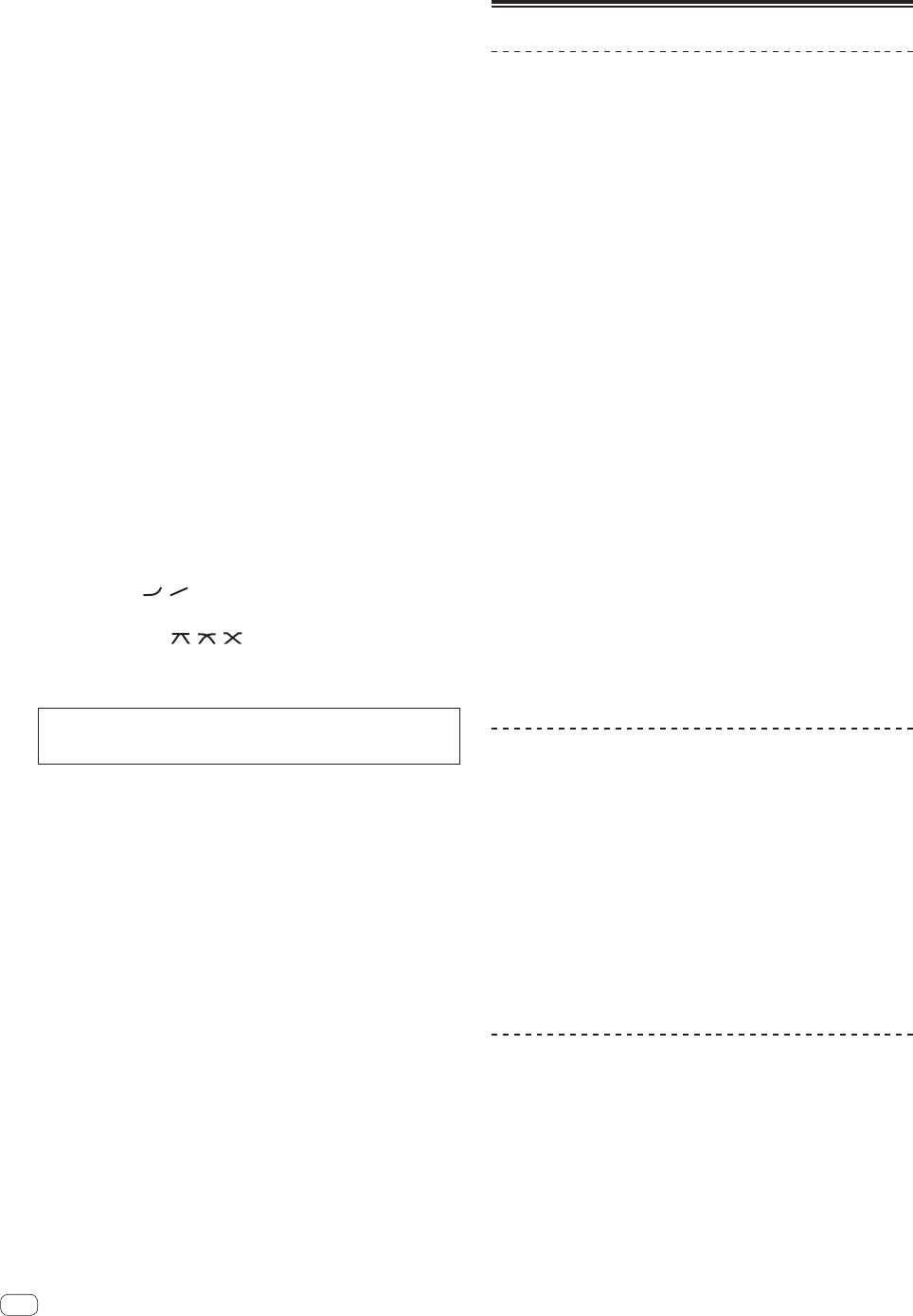
8
En
b EQ/ISO (HI, MID, LOW) controls (page 8)
These adjust the sound quality of the respective channels.
c CUE button (page 8)
Presses the [CUE] button(s) for the channel(s) you want to monitor.
d Channel Fader (page 8)
Adjusts the level of audio signals output in each channel.
e CROSS FADER ASSIGN (A, THRU, B) selector switch
(page 8)
Sets the output destination of each channel to [A] or [B].
f Crossfader (page 8)
Outputs audio signals assigned by the crossfader assign switch cor-
responding to the curve characteristics selected by [CROSS FADER]
(Crossfader Curve Selector Switch).
g MASTER LEVEL control (page 8)
Adjusts the audio level output from the [MASTER1] and [MASTER2]
terminals.
h Master Level Indicator (page 8)
Displays the audio level output from the [MASTER1] and [MASTER2]
terminals.
i MONO, STEREO selector switch (page 9)
Switches the sound output from the [MASTER1] terminals, etc.,
between monaural and stereo.
j BOOTH MONITOR control (page 9)
Adjusts the level of audio signals output from the [BOOTH] terminal.
k EQ CURVE (ISOLATOR, EQ) selector switch (page 8)
Switches the function of the [EQ/ISO (HI, MID, LOW)] controls.
l CH FADER ( , ) selector switch (page 9)
Switches the channel fader’s curve characteristics.
m CROSS FADER ( , , ) selector switch (page 9)
This switches the crossfader curve characteristics.
n Main unit display
Do not pull on the channel fader and crossfader knobs with excessive
force. The knobs have a structure by which they cannot be pulled off
easily. Pulling the knobs strongly may result in damaging the unit.
Basic Operation
Outputting sound
1 Press [POWER] button.
Turn on the power of this unit.
2 Switch the input selector switches.
Selects the input sources for the different channels from among the
devices connected to this unit.
— [PHONO]: Selects the analog player connected to the [PHONO]
terminals.
— [CD/LINE], [LINE]: Selects the DJ player or cassette deck con-
nected to the [CD/LINE] or [LINE] terminals.
— [USB */*]: Selects the sound of the computer connected to the
[USB] port.
3 Turn the [TRIM] control.
Adjusts the level of audio signals input in each channel.
The corresponding channel level indicator lights when audio signals are
being properly input to that channel.
4 Move the channel fader away from you.
Adjusts the level of audio signals output in each channel.
5 Switch the [CROSS FADER ASSIGN (A, THRU, B)]
selector switch.
Switches the output destination of each channel.
— [A]: Assigns to [A] (left) of the crossfader.
— [B]: Assigns to [B] (right) of the crossfader.
— [THRU]: Selects this when you do not want to use the crossfader.
(The signals do not pass through the crossfader.)
6 Set the crossfader.
This operation is not necessary when the [CROSS FADER ASSIGN (A,
THRU, B)] selector switch is set to [THRU].
7 Turn the [MASTER LEVEL] control.
Audio signals are output from the [MASTER1] and [MASTER2]
terminals.
The master level indicator lights.
Adjusting the sound quality
Turn the [EQ/ISO (HI, MID, LOW)] controls for the
respective channels.
The adjustable ranges for the respective controls are as shown below.
! HI: –26 dB to +6 dB (13 kHz)
! MID: –26 dB to +6 dB (1 kHz)
! LOW: –26 dB to +6 dB (70 Hz)
Switching the function of the [EQ/ISO (HI, MID,
LOW)] controls
Switch the [EQ CURVE (ISOLATOR, EQ)] selector switch.
— [ISOLATOR]: Functions as an isolator.
— [EQ]: The equalizer function is set.
Monitoring sound with headphones
1 Connect headphones to the [PHONES] terminal.
2 Press the [CUE] button(s) for the channel(s) you want
to monitor.
3 Switch the [MONO SPLIT, STEREO] selector switch.
— [MONO SPLIT]: The sound of the channels for which the [CUE]
button is pressed is output from the headphones output’s left
channel, the [MASTER] channel sound is output from the right
channel.
— [STEREO]: The sound of the channels for which the [CUE] button
is pressed is output from the headphones in stereo.














